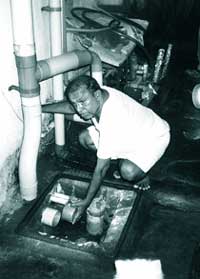| |
|
PERSPECTIVE |
|
| National water policy A futile
exercise |
|
IN FOCUS |
|
| Water riots breakout in Gujarat Bustards under threat Disappearing lakes and ponds |
|
INITIATIVE |
|
| Delhi prepares to catch rain Watering schools Ready to take action Gokak goes green Journalist's meet |
|
TECHNOLOGY |
|
| Easy steps to catch rain |
|
CSE'S LATEST DESIGNS |
|
| Sankat Mochan Mandir A role model in the making |
|
CHENNAI PAGE |
|
| Water suficient Municipal water bonds Active campaigner |
|
PROFILE |
|
| Water crusader |
|
TRADITION |
|
| Kata system |
|
NEWS FROM ABROAD |
|
| A water conscious city Ghana's privatisation woes |
|
OBITUARY |
|
| Vilasrao Salunke |
|
BOOK / DOCUMENTS |
|
| Glimpses of book |
|
EVENTS |
|
| Conference call |
|

Vol. 4
No.
2
April 2002
![]()
Water suficient
People of Padmanabha Nagar (PN) in Adyar, a residential colony situated in coastal track of Chennai city have effectively resolved their drinking water problem, by adopting rainwater harvesting technique.
 |
The rainwater drainpipe carry water to sump |
It all started in 2001, when Chennai was going through a period of severe water scarcity. This colony of 65 individual houses, covering an area of around three acres was also facing a problem due to seawater intrusion. The state water supply was not only irregular but limited in quantity as well, thus compelling people to buy water. The middle class resident’s of PN were spending about Rs 2,000 – Rs 3,000 per month on water.
Venkatraman, president of PN welfare association, decided to adopt the technique of rainwater harvesting in his colony. He was assisted by Shekhar Raghavan, a Chennai-based rainwater harvesting facilitator. Venkatraman decided to begin with his house. To demonstrate the benefits of this technique to other residents he designed a diversion pipe (a four inch PVC pipe bend with a reducer of four inch to one inch that can be fitted with any rooftop water downtake pipe of four inch diameter) through which water can be diverted to any part of the house. Initially, to popularise rainwater harvesting among the residents, he also announced a subsidy of Rs 250 for feasibility study.
In 2001, when one night of rain filled the sumps of 4,000 litre capacity with water, people started realising the potential of rainwater harvesting. Today, 54 houses in PN are catching rain.
The designs used are simple. Venkataraman explains, "Rooftop rainwater is diverted to sumps for direct usage". To reduce the cost, pipes near the sump and dug wells are used.
Rainwater harvesting is also strengthening inter community bonds in PN. As Venkatarman narrates, "When Seshadri, a PN resident decided to go for water harvesting, he realised that his neighbour – Krishnaswamy and Afzal’s pipes runs near his dug well. Thus, it would be in everyone’s interest to take collective action. Both of them not only agreed but also gave their financial contribution for the project."It clearly shows that water knows no boundaries of caste or religion – it stays with people, who respects and conserves it.
For further information:
Sekhar Raghavan
Sitalakshmi Raghavan
Memorial Social and Charitable trust,
D15, Bayview Apartments,
Kalakshetra Colony,
Besant Nagar,
Chennai 600 090